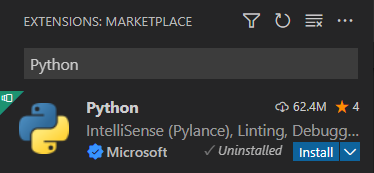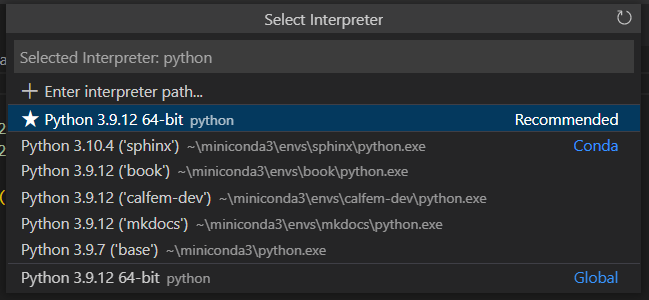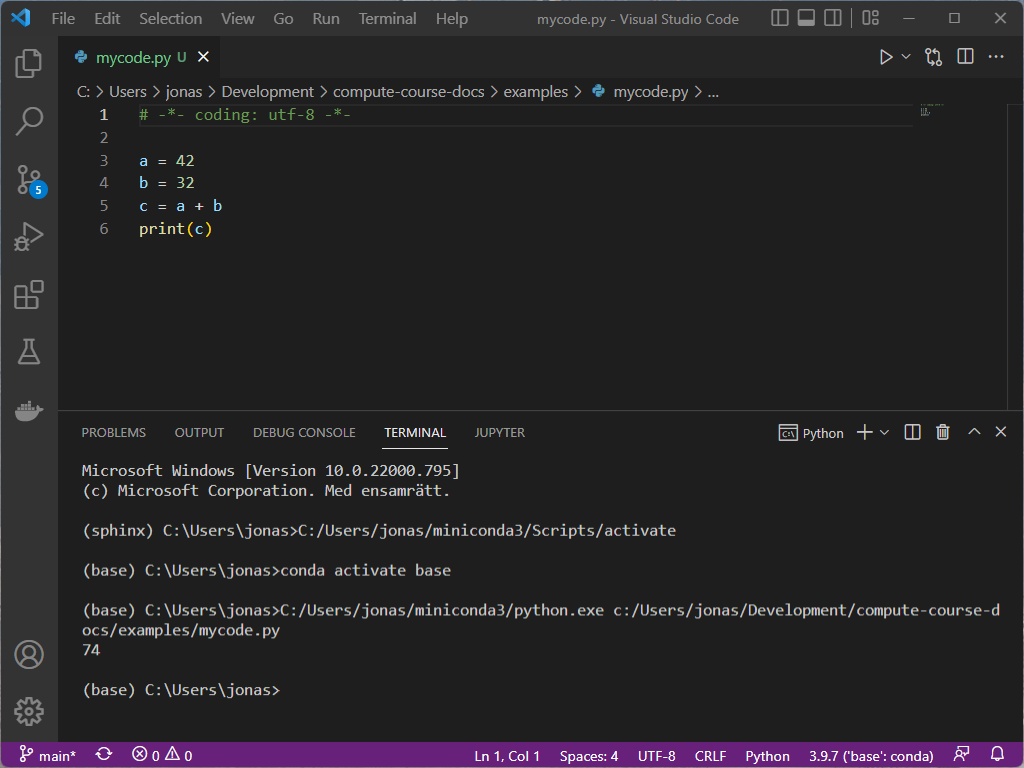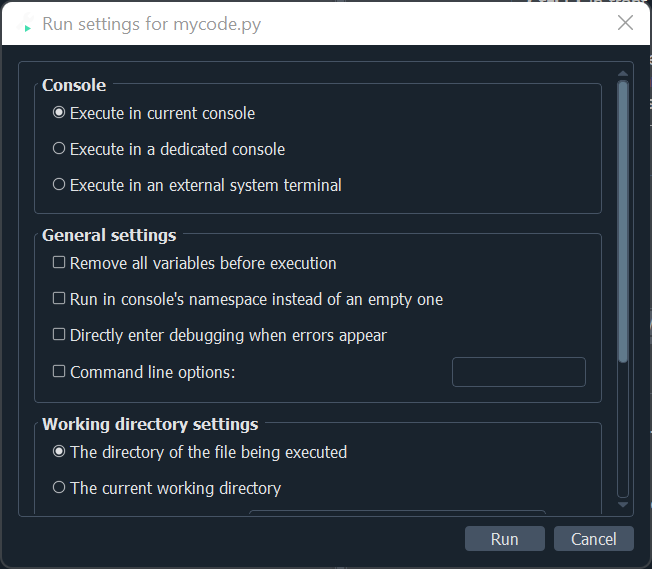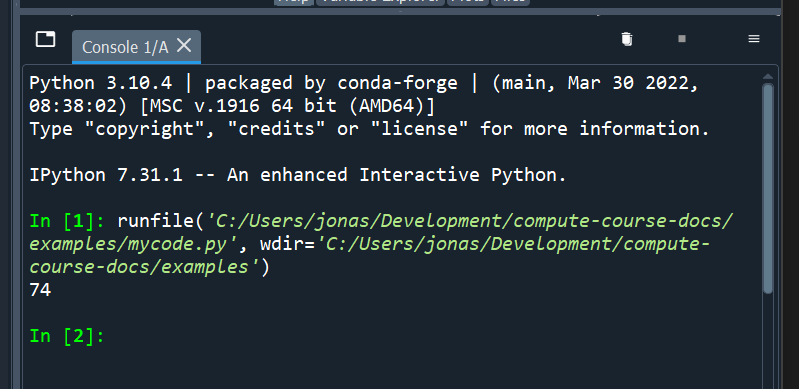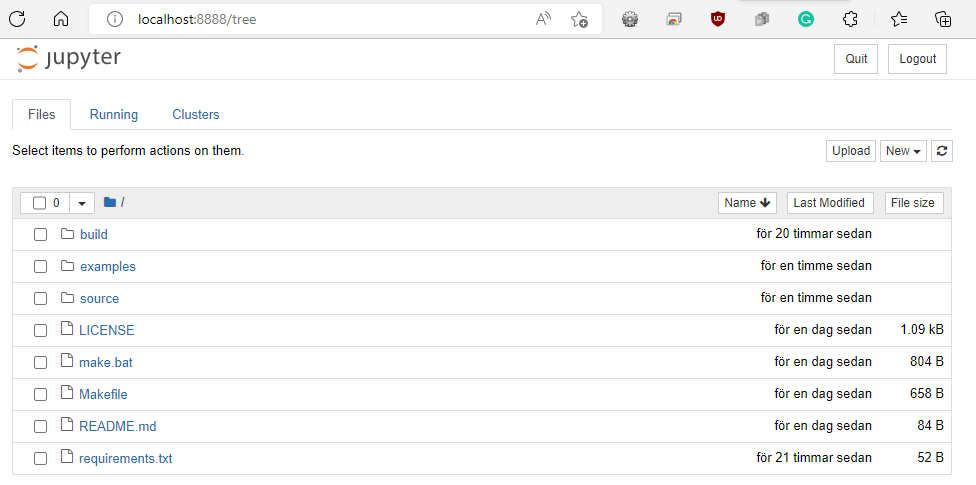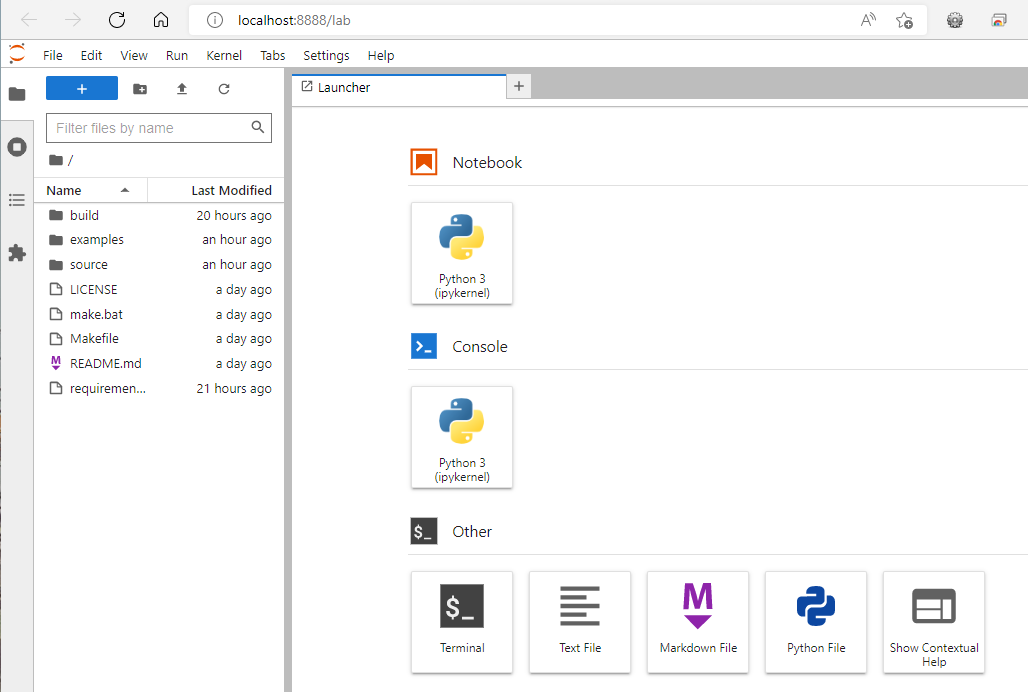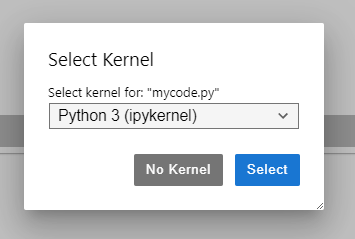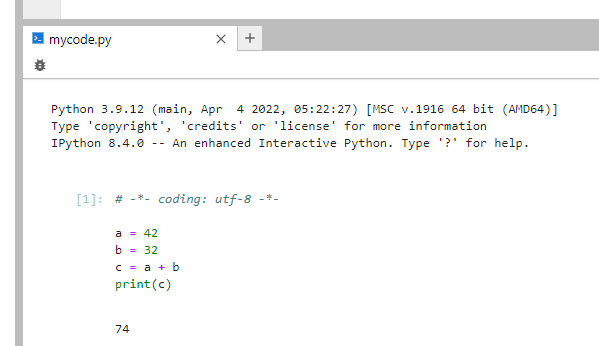Python¶
Setting up a Python environment¶
Installing Python distribution Anaconda¶
Anaconda is a prepackaged Python distribution for scientific computing. The distribution can be downloaded from here:
Run the installer to install Anaconda.
Using Anaconda in Windows¶
The installer will create a shortcut to an Anaconda command prompt, which opens a terminal with the paths setup for running Python and other Anaconda installed tools.
To verify that Anaconda has been installed correctly type the following commands in a command prompt (versions can differ):
(base) C:\Users\jonas\Development\compute-course-docs>python -V
Python 3.9.7
(base) C:\Users\jonas\Development\compute-course-docs>conda --version
conda 4.13.0
Using Anaconda on macOS¶
The installer will update the Terminal-scripts with search paths for the Anaconda install. To access the Anaconda provided tools and Python, open the Terminal application in macOS.
To verify that Anaconda has been installed correctly type the following commands in a command prompt (versions can differ):
(base) $ python -V
Python 3.9.7
(base) $ conda --version
conda 4.13.0
Starting the Development environment Spyder¶
The default development environment for Anaconda and scientific development is Spyder, which is installed together with Anaconda. The Spyder development environment can be started by typing spyder in an anaconda prompt or terminal.
(base) $ spyder
Installing Visual Studio Code¶
Visual Studio Code is general code editor from Microsoft supporting multiple languages through a plugin architecture. Microsoft also provides excellent Python support through their own Python-plugins. Visual Studio Code is available for all platforms and can be downloaded from here:
https://code.visualstudio.com/
Installing Visual Studio Python extensions¶
To make it possible to run Python and notebooks in Visual Studio Code we need to install some additional Plugins. The first one is the general Python plugin. To install plugins click on the plugins-button in the toolbar to the left in visual studio code:
Next, enter Python in the search bar top left in the window:
Click the Install button to install the plugin in Visual Studio Code.
If you want to open Jupyter Notebooks directly in Visual Studio Code, this can be enabled by installing the following plugins:
Jupyter - Microsoft
Jupyter Keymap - Microsoft
Jupyter Notebook Renderers - Microsoft
Running Python code¶
Python is a script language and Python code can be run in many different ways. This chapter will try to cover all the ways you can run your Python code.
Executing code from the command line (python)¶
All Pytho installations comes with an interpreter for Python. This is a command line tool that can be used to execute Python code. Just running the interpreter without any arguments starts an interactive Python prompt as shown below:
(base) C:\Users\jonas>python
Python 3.9.7 (default, Sep 16 2021, 16:59:28) [MSC v.1916 64 bit (AMD64)] :: Anaconda, Inc. on win32
Type "help", "copyright", "credits" or "license" for more information.
>>>
The >>> is the Python interactive prompt. Here you can enter python commands and functions directly. In the following example 3 python variables are created and finally the variable c is printed.:
>>> a = 42
>>> b = 32
>>> c = a + b
>>> print(c)
74
Using the Python interactive shell enables you to do experiment with Python interactively. To exit the interpreter press Ctrl-Z.
Running Python source files (.py)¶
The interpreter can also execute Python code from text files, usually with the .py extension. The code shown in the interactive example can be put in a source file, mycode.py, with the following content:
# -*- coding: utf-8 -*-
a = 42
b = 32
c = a + b
print(c)
The first line is not required, but tells Python that the source code can contain unicode characters (öäå). This source file can then be executed by calling the python command with the Python source file as the first argument.:
(base) C:\Users\jonas\Development\compute-course-docs\examples>python mycode.py
74
Running Python source files in Visual Studio Code¶
When the Python-plugins has been installed in Visual Studio Code (VSCode) it is possible to run Python-source files directly in the application. If a Python source file is open a special toolbar is shown in the top right corner with a play-button as shown in the followin figure:
Before we can runt the source file in VSCode, the correct Python interpreter must be selected. Selecting a Python interpreter is done by clicking in the status bar in the lower right corner of the window.
This brings up a list of all the installed Python interpreters. Select the one you want to use. The default Anaconda interpreter is prefixed with (base).
When an interpreter has been selected it is now possible to execute the Python source by clicking the play-button. This will open an output pane in VSCode and show execution and output from the execution of the source file.
Running Python source files in Spyder¶
Spyder is the default development environment that comes with the Anaconda distribution. Spyder uses the default Python interpreter in the base environment of the Anaconda distribution.
Running a Python source file in Spyder is done by opening it using File/Open.. menu and choosing Run/Run menu. It is also possible to use the function key F5 directly. This executes the source file and shows the output in the Console tab in the lower right of the window.
Spyder always asks you where you want to execute the Python file, by displaying the following dialog:
By default is uses the Python interpreter running in the Console-tab in the lower right. The second option is running in a dedicated console. This alternative will start a new Python interpreter running in a separate tab. The third option is to run in an external terminal. As Spyder is also a Python application it can sometimes be beneficial to run your code outside the Spyder environment. This is especially important when developing graphical user interface applications (PyQt).
When running in the default console it can be a good idea to check the option Remove all variables before execution, otherwise all existing variables from the last run are kept.
If there where no errors the output is shown in the console tab.
Running Jupyter-notebooks¶
Another way to run Python code is to use Jupyter-Notebooks. In the Anaconda distribution a notebook can be started using the jupyuter-notebook command. This will start a notebook web server running on your local computer. The url will to access the server is displayed in the output from the command:
(base) C:\Users\jonas\Development\compute-course-docs>jupyter-notebook
[I 10:39:47.869 NotebookApp] Writing notebook server cookie secret to C:\Users\jonas\AppData\Roaming\jupyter\runtime\notebook_cookie_secret
...
[C 10:39:48.772 NotebookApp]
To access the notebook, open this file in a browser:
file:///C:/Users/jonas/AppData/Roaming/jupyter/runtime/nbserver-19148-open.html
Or copy and paste one of these URLs:
http://localhost:8888/?token=089...88
or http://127.0.0.1:8888/?token=089...88
In most cases the jupyter-notebook-command will try to open the url automatically in your browser. The server can be stopped by clicking Ctrl-C multiple times.
There is a second command that starts a more advanced notebook server, jupyter-lab:
The jupyter-lab server can also be used to edit and run python source files (.py). To do this you have to open the source file and create a Python console/interpreter for the opened editor. To do this, right-click in the editor window and select Create Console for Editor.
This brings up a dialog asking for what kind of Python interpreter you want:
Click Select to continue. This opens up a lower pane with the started interpreter. To run code select Run/Run All code from the menu in Jupyter-lab.
How to use Python virtual environments¶
Python can use a lot of third-party extension modules. Complex projects can depend on a lot of these modules. Installing extension modules in the base installation can work for smaller projects and scripts. However different projects can have dependencies on different incompatible libraries, making it hard to maintain an single Python installation for multiple projects. To solve this, Python contains a mechanism for creating isolated python environments that each can have it’s own set of extension modules installed. This mechanics is called virtual environments and is accessible through the venv module.
A virtual environment contains is a copy of the Python base installation with only the absolute minimum of installed packages.
Using a virtual enviromnents (venv)¶
Creating a virtual environment is done by the following command:
python -m venv myenv
This will create a separate directory, myenv, where copy of the Python base install will be installed. To use this new environment it has to be activated. This is done by calling/sourcing a special script that is available inside the environment, activate. On a windows installation a virtual environment is activated by calling:
myenv\Scripts\activate.bat
On a Linux/Mac environment the environment is activated by sourcing:
source myenv/bin/activate
When an enviromnent is activte the prompt is changed to display the currently active environment:
(myenv) (base) E:\Users\Jonas\Development\python_dev_doc\examples>
If the environment is no longer used it can be deactivated using the following commands:
myenv\Scripts\deactivate.bat
On a Linux/Mac environment the environment is activated by sourcing:
source myenv/bin/deactivate
Managing packages in virtual environment¶
Packages or third-party packages in a virtual environment are installed and managed using the pip command just like in a base Python installation. The difference is that a newly created environment only holds just the required packages for the environment to work.
Available packages in an enviromnent can be listed using the pip list command:
$ pip list
Running this command in a base installation will produce a long list of packages:
$ pip list
Package Version
---------------------------------- -------------------
alabaster 0.7.12
anaconda-client 1.7.2
anaconda-navigator 2.0.3
anaconda-project 0.9.1
anyio 2.2.0
appdirs 1.4.4
argh 0.26.2
argon2-cffi 20.1.0
asn1crypto 1.4.0
astroid 2.5
astropy 4.2.1
async-generator 1.10
atomicwrites 1.4.0
attrs 20.3.0
autopep8 1.5.6
Babel 2.9.0
Doing the same thing in a newly created environment produces the following output.
pip list
Package Version
---------- -------
pip 20.2.3
setuptools 49.2.1
Using virtualenv to create environments¶
virtualenv is a tool that provides additional options and also makes it easier to create virtual environments. This should preferable be installed in the base Python installation. The tool is installed using the following command:
pip install virtualenv
Creating reproducable environments¶
In many scientific workflows it is important to create reproducable workflows. This also extends to scientific software. Virtual environments are excellent to create a reproducable set of dependencies for a scientific workflow.
When a environment has been created and packages have been installed, it is possible to create a list of required packages that can be used to recreate the excact environment. Using the pip freeze command it is possible to create a list of requirements that can be used as input in a pip install command.
In the following example we will create a requirements.txt file containing the needed modules in the myenv environment. Listing the installed packages produces the following output:
$ pip list
Package Version
----------------- -------
calfem-python 3.5.10
cycler 0.10.0
gmsh 4.8.4
kiwisolver 1.3.1
matplotlib 3.4.3
numpy 1.21.2
Pillow 8.3.1
pip 21.2.4
PyOpenGL 3.1.5
pyparsing 2.4.7
PyQt5 5.15.4
PyQt5-Qt5 5.15.2
PyQt5-sip 12.9.0
PyQtWebEngine 5.15.4
PyQtWebEngine-Qt5 5.15.2
python-dateutil 2.8.2
PyVTK 0.5.18
scipy 1.7.1
setuptools 49.2.1
six 1.16.0
visvis 1.13.0
wheel 0.37.0
Using the pip freeze command we can create a list of requirements.
$ pip freeze > requirements.txt
$ cat requirements.txt
calfem-python==3.5.10
cycler==0.10.0
gmsh==4.8.4
kiwisolver==1.3.1
matplotlib==3.4.3
numpy==1.21.2
Pillow==8.3.1
PyOpenGL==3.1.5
pyparsing==2.4.7
PyQt5==5.15.4
PyQt5-Qt5==5.15.2
PyQt5-sip==12.9.0
PyQtWebEngine==5.15.4
PyQtWebEngine-Qt5==5.15.2
python-dateutil==2.8.2
PyVTK==0.5.18
scipy==1.7.1
six==1.16.0
visvis==1.13.0
On Windows use type requirements.txt.
Using this file it is now possible to recreate a new environment using the following commands:
$ python -m venv newenv
$ newenv/Scripts/activate.bat
(newenv) $ pip install -r myenv\requirements.txt
Collecting calfem-python==3.5.10
Using cached calfem_python-3.5.10-py3-none-any.whl (70 kB)
Collecting cycler==0.10.0
...
Successfully installed Pillow-8.3.1 PyOpenGL-3.1.5 PyQt5-5.15.4 PyQt5-Qt5-5.15.2 PyQt5-sip-12.9.0 PyQtWebEngine-5.15.4 PyQtWebEngine-Qt5-5.15.2 PyVTK-0.5.18 calfem-python-3.5.10 cycler-0.10.0 gmsh-4.8.4 kiwisolver-1.3.1 matplotlib-3.4.3 numpy-1.21.2 pyparsing-2.4.7 python-dateutil-2.8.2 scipy-1.7.1 six-1.16.0 visvis-1.13.0
If we activate and list the packages we should get the same packages in newenv as in myenv.
$ pip list
Package Version
----------------- -------
calfem-python 3.5.10
cycler 0.10.0
gmsh 4.8.4
kiwisolver 1.3.1
matplotlib 3.4.3
numpy 1.21.2
Pillow 8.3.1
pip 20.2.3
PyOpenGL 3.1.5
pyparsing 2.4.7
PyQt5 5.15.4
PyQt5-Qt5 5.15.2
PyQt5-sip 12.9.0
PyQtWebEngine 5.15.4
PyQtWebEngine-Qt5 5.15.2
python-dateutil 2.8.2
PyVTK 0.5.18
scipy 1.7.1
setuptools 49.2.1
six 1.16.0
visvis 1.13.0
We now have an exact copy of the myenv environment. This can be useful to recreate the requiremenets for a scientific software package on a different system or resource.
Using pipenv to manage environments and packages¶
virtualenv, venv and pip are essential tools for creating a reproducable environment for Python applications. However, they are separate tools which require many manual steps to setup a working environment for an application.
Pipenv is a tool that combines package and environment creation in a single tool and automatically handles requirements.
Advantages with Pipenv are:
Single tool to manage packages and virtual environments
Better handling of requirements
Everything is hashed to ensure security.
Make sure the latest packages are used.
Installing pipenv¶
Pipenv can be installed using the following commands:
$ pip install pipenv
It can also be installed in your home directory using:
$ pip install --user pipenv
Setting up a pipenv project¶
Pipenv is best used in a project setting. That is all project related source code and files are located in a single directory. This directory will be the base for the Pipenv environment and package data. An example of how to setup a project with Pipenv is shown below:
$ mkdir myproj
$ cd myproj
$ pipenv install
Creating a virtualenv for this project...
Pipfile: E:\Users\Jonas\Development\python_dev_doc\examples\myproj\Pipfile
Using E:/Program Files (x86)/Microsoft Visual Studio/Shared/Python37_64/python.exe (3.7.8) to create virtualenv...
[ =] Creating virtual environment...created virtual environment CPython3.7.8.final.0-64 in 4414ms
creator CPython3Windows(dest=C:\Users\Jonas Lindemann\.virtualenvs\myproj-jNDwD6z3, clear=False, no_vcs_ignore=False, global=False)
seeder FromAppData(download=False, pip=bundle, setuptools=bundle, wheel=bundle, via=copy, app_data_dir=C:\Users\Jonas Lindemann\AppData\Local\pypa\virtualenv)
added seed packages: pip==21.1.3, setuptools==57.4.0, wheel==0.36.2
activators BashActivator,BatchActivator,FishActivator,PowerShellActivator,PythonActivator,XonshActivator
Successfully created virtual environment!
Virtualenv location: C:\Users\Jonas Lindemann\.virtualenvs\myproj-jNDwD6z3
Creating a Pipfile for this project...
Pipfile.lock not found, creating...
Locking [dev-packages] dependencies...
Locking [packages] dependencies...
Updated Pipfile.lock (a65489)!
Installing dependencies from Pipfile.lock (a65489)...
================================ 0/0 - 00:00:00
To activate this project\'s virtualenv, run pipenv shell.
Alternatively, run a command inside the virtualenv with pipenv run.
Please note that on Windows it used the default Python installation on your system and not the Python interpreter in the PATH. If you want to build the environment using a specific Python interpreter use the following command instead:
$ pipenv --python [path to python interpreter] install
This will create 2 files in the project directory. A Pipfile and a Pipfile.lock. The Pipfile contains the dependencies for the project and the Pipfile.lock contains the latest tested combination of packages.
A typical Pipfile is shown below:
[[source]]
url = "https://pypi.org/simple"
verify_ssl = true
name = "pypi"
[packages]
calfem-python = "*"
[dev-packages]
[requires]
python_version = "3.8"
Installing packages¶
Packages can be installed in the project using the pipenv install command. In the following command we install the calfem-python package in the current pipenv project.
$ cd myproj
$ pipenv install calfem-python
Installing calfem-python...
Adding calfem-python to Pipfile\'s [packages]...
Installation Succeeded
Pipfile.lock (db4242) out of date, updating to (656452)...
Locking [dev-packages] dependencies...
Locking [packages] dependencies...
Building requirements...
Resolving dependencies...
Success!
Updated Pipfile.lock (656452)!
Installing dependencies from Pipfile.lock (656452)...
================================ 0/0 - 00:00:00
To activate this project\'s virtualenv, run pipenv shell.
Alternatively, run a command inside the virtualenv with pipenv run.
This will add calfem-python to the
Running a project using pipenv¶
We now have a project that can use the calfem-python moduel with all its dependencies. We now create a main python file, fea_analysis.py in our project directory with the following contents:
import numpy as np
import calfem.core as cfc
# ----- Topology -------------------------------------------------
Edof = np.array([
[1, 2, 3, 4, 5, 6],
[4, 5, 6, 7, 8, 9],
[7, 8, 9, 10, 11, 12]
])
# ----- Stiffness matrix K and load vector f ---------------------
K = np.mat(np.zeros((12,12)))
f = np.mat(np.zeros((12,1)))
f[4] = -10000.
# ----- Element stiffness matrices ------------------------------
E = 2.1e11
A = 45.3e-4
I = 2510e-8
ep = np.array([E,A,I])
ex = np.array([0.,3.])
ey = np.array([0.,0.])
Ke = cfc.beam2e(ex,ey,ep)
print(Ke)
# ----- Assemble Ke into K ---------------------------------------
K = cfc.assem(Edof,K,Ke);
# ----- Solve the system of equations and compute support forces -
bc = np.array([1,2,11])
(a,r) = cfc.solveq(K,f,bc);
# ----- Section forces -------------------------------------------
Ed=cfc.extractEldisp(Edof,a);
es1, ed1, ec1 = cfc.beam2s(ex, ey, ep, Ed[0,:], nep=10)
es2, ed2, ec2 = cfc.beam2s(ex, ey, ep, Ed[1,:], nep=10)
es3, ed3, ec3 = cfc.beam2s(ex, ey, ep, Ed[2,:], nep=10)
# ----- Results --------------------------------------------------
print("a=")
print(a)
print("r=")
print(r)
print("es1=")
print(es1)
print("es2=")
print(es2)
print("es3=")
print(es3)
print("ed1=")
print(ed1)
print("ed2=")
print(ed2)
print("ed3=")
print(ed3)
It is possible to run the project by issuing the following command:
$ pipenv run fea_analysis.py
[[ 3.17100000e+08 0.00000000e+00 0.00000000e+00 -3.17100000e+08
0.00000000e+00 0.00000000e+00]
[ 0.00000000e+00 2.34266667e+06 3.51400000e+06 0.00000000e+00
-2.34266667e+06 3.51400000e+06]
...
[ 0. -0.01992032]
[ 0. -0.01823785]]
ed3=
[[ 0.00000000e+00 -1.99203187e-02]
[ 0.00000000e+00 -1.82378462e-02]
[ 0.00000000e+00 -1.63679985e-02]
[ 0.00000000e+00 -1.43341976e-02]
[ 0.00000000e+00 -1.21598653e-02]
[ 0.00000000e+00 -9.86842362e-03]
[ 0.00000000e+00 -7.48329434e-03]
[ 0.00000000e+00 -5.02789938e-03]
[ 0.00000000e+00 -2.52566063e-03]
[ 0.00000000e+00 1.73472348e-18]
[ 0.00000000e+00 2.52566063e-03]]
Executing a shell in the created environment¶
It is also possible to create a shell with the created project environment. From this shell it is possible to examine the installed packaged using the pipenv graph:
$ pipenv shell
Launching subshell in virtual environment...
(myproj-jNDwD6z3) (base) $ pip list
Package Version
----------------- -------
calfem-python 3.5.10
cycler 0.10.0
gmsh 4.8.4
kiwisolver 1.3.1
matplotlib 3.4.3
numpy 1.21.2
Pillow 8.3.1
pip 21.1.1
PyOpenGL 3.1.5
pyparsing 2.4.7
PyQt5 5.15.4
PyQt5-Qt5 5.15.2
PyQt5-sip 12.9.0
PyQtWebEngine 5.15.4
PyQtWebEngine-Qt5 5.15.2
python-dateutil 2.8.2
PyVTK 0.5.18
scipy 1.7.1
setuptools 56.0.0
six 1.16.0
visvis 1.13.0
wheel 0.36.2
When you don’t want to use the environment anymore just type exit and you are back in your previous environment.
Listing package dependencies¶
Using the pipenv graph it is also possible to list the dependencies of a project:
$ pipenv graph
calfem-python==3.5.10
- gmsh [required: Any, installed: 4.8.4]
- matplotlib [required: Any, installed: 3.4.3]
- cycler [required: >=0.10, installed: 0.10.0]
- six [required: Any, installed: 1.16.0]
- kiwisolver [required: >=1.0.1, installed: 1.3.1]
- numpy [required: >=1.16, installed: 1.21.2]
- pillow [required: >=6.2.0, installed: 8.3.1]
- pyparsing [required: >=2.2.1, installed: 2.4.7]
- python-dateutil [required: >=2.7, installed: 2.8.2]
- six [required: >=1.5, installed: 1.16.0]
- numpy [required: Any, installed: 1.21.2]
- pyqt5 [required: Any, installed: 5.15.4]
- PyQt5-Qt5 [required: >=5.15, installed: 5.15.2]
- PyQt5-sip [required: >=12.8,<13, installed: 12.9.0]
- pyqtwebengine [required: Any, installed: 5.15.4]
- PyQt5 [required: >=5.15.4, installed: 5.15.4]
- PyQt5-Qt5 [required: >=5.15, installed: 5.15.2]
- PyQt5-sip [required: >=12.8,<13, installed: 12.9.0]
- PyQt5-sip [required: >=12.8,<13, installed: 12.9.0]
- PyQtWebEngine-Qt5 [required: >=5.15, installed: 5.15.2]
- pyvtk [required: Any, installed: 0.5.18]
- six [required: Any, installed: 1.16.0]
- scipy [required: Any, installed: 1.7.1]
- numpy [required: >=1.16.5,<1.23.0, installed: 1.21.2]
- visvis [required: Any, installed: 1.13.0]
- numpy [required: Any, installed: 1.21.2]
- pyOpenGl [required: Any, installed: 3.1.5]
This command does not require the project environment to be activated.
Updating packages in a project¶
Installed packages in a project can be updated using the pipenv update command in your project directory.
$ pipenv update --outdated
Locking...Building requirements...
Resolving dependencies...
Success!
Skipped Update of Package visvis: 1.13.0 installed,, 1.13.0 available.
Skipped Update of Package six: 1.16.0 installed,, 1.16.0 available.
Skipped Update of Package scipy: 1.7.1 installed,, 1.7.1 available.
Skipped Update of Package PyVTK: 0.5.18 installed,, 0.5.18 available.
Skipped Update of Package python-dateutil: 2.8.2 installed,, 2.8.2 available.
Skipped Update of Package PyQtWebEngine: 5.15.4 installed,, 5.15.4 available.
Skipped Update of Package PyQtWebEngine-Qt5: 5.15.2 installed,, 5.15.2 available.
Skipped Update of Package PyQt5: 5.15.4 installed,, 5.15.4 available.
Skipped Update of Package PyQt5-sip: 12.9.0 installed,, 12.9.0 available.
Skipped Update of Package PyQt5-Qt5: 5.15.2 installed,, 5.15.2 available.
Skipped Update of Package pyparsing: 2.4.7 installed,, 2.4.7 available.
Skipped Update of Package PyOpenGL: 3.1.5 installed,, 3.1.5 available.
Skipped Update of Package Pillow: 8.3.1 installed,, 8.3.1 available.
Skipped Update of Package numpy: 1.21.2 installed,, 1.21.2 available.
Skipped Update of Package matplotlib: 3.4.3 installed,, 3.4.3 available.
Skipped Update of Package kiwisolver: 1.3.1 installed,, 1.3.1 available.
Skipped Update of Package gmsh: 4.8.4 installed,, 4.8.4 available.
Skipped Update of Package cycler: 0.10.0 installed,, 0.10.0 available.
Skipped Update of Package calfem-python: 3.5.10 installed, 3.5.10 required (Unpinned in Pipfile), 3.5.10 available.
All packages are up to date!
How to use Conda environments¶
Anaconda is one of the largest commercial Python distributions. It has become a defacto standard for packaging Scientific Software and comes with it’s own packaging system, conda. If you are developing software using Anaconda the preferred way of installing software is by using the conda command line tool. If the packages are available in Anaconda’s package-repos they are tested to work together. It is often also not a good idea to mix conda and pip package-repositories.
In many situations it is often required to use both pip and conda packages. In these situations it is possible within Anaconda to create conda environments. These are derived from the builtin virtual environment tools in Python, but extended and made easier to use.
Creating a Anaconda environment¶
An anaconda environment is created using the conda create command. As shown in the following example:
$ conda create -n calfem-test
Collecting package metadata (current_repodata.json): done
Solving environment: done
## Package Plan ##
environment location: e:\anaconda3\envs\calfem-test
Proceed ([y]/n)? y
Preparing transaction: done
Verifying transaction: done
Executing transaction: done
#
# To activate this environment, use
#
# $ conda activate calfem-test
#
# To deactivate an active environment, use
#
# $ conda deactivate
This creates a new empty environment ready for use.
This environment doesn’t come with a Python interpreter, so that has to be installed by using:
$ conda install python
This will install the latest Python interpreter in the new environment
It is also possible to do this in a single command:
$ conda create -n calfem-test python
It is also possible to specify more packages to install by adding them on the command line.
The version of Python or packages can be specified by using an equal sign and a version number as shown below:
$ conda create -n calfem-test python=3.8
This will create an environment with the latest version of Python 3.8.
Activating and deactivating Anaconda environments¶
To use an environment it has be activated. Activating an environment is done using the conda activate command. The command takes name of the environment as an additional parameter. In the following example we activate the previously created environment:
$ conda activate calfem-test
(calfem-test) $
This will setup all the search paths for the environment. The prompt is also modified to indicate which environment is activate.
Please note that creating an empty environment does not come with an Python interpreter by default.
An environment can be deactivate by using the conda deactivate command:
(calfem-test) $ conda deactivate
(base) $
No environment name is required for deactivating an environment.
Removing an environment¶
Removing a created environment is done using the conda env remove command:
conda env remove -n calfem-test
Remove all packages in environment e:anaconda3envscalfem-test:
(base) $ conda remove -n calfem-test
Remove all packages in environment e:\anaconda3\envs\calfem-test:
...
Cloning an existing environment¶
An exact copy of an existing environment can be created using the –clone option:
(base) $ conda create -n calfem-dev-2 --clone calfem-test
Source: e:\anaconda3\envs\calfem-dev
Destination: e:\anaconda3\envs\calfem-dev-2
Packages: 158
Files: 13121
Exporting an Anaconda environment¶
You can list all packages and their versions using the conda list command:
(base) $ conda list calfem-dev --explicit
# This file may be used to create an environment using:
# $ conda create --name <env> --file <this file>
# platform: win-64
@EXPLICIT
https://repo.anaconda.com/pkgs/main/win-64/ca-certificates-2021.7.5-haa95532_1.conda
https://repo.anaconda.com/pkgs/main/noarch/tzdata-2021a-h5d7bf9c_0.conda
https://repo.anaconda.com/pkgs/main/noarch/pyopenssl-20.0.1-pyhd3eb1b0_1.conda
...
https://repo.anaconda.com/pkgs/main/noarch/urllib3-1.26.6-pyhd3eb1b0_1.conda
https://repo.anaconda.com/pkgs/main/noarch/requests-2.26.0-pyhd3eb1b0_0.conda
https://repo.anaconda.com/pkgs/main/noarch/sphinx-4.0.2-pyhd3eb1b0_0.conda
This list can also be saved to a file that then can be used to recreate the environment.
(base) $ conda list calfem-dev --explicit > spec-file.txt
Using this file it is now possible to create an environmnet with the exact set of packages.
(base) conda create --name calfem-dev-3 --file spec-file.txt
Preparing transaction: done
Verifying transaction: done
Executing transaction:
...
Conda and pip¶
Pip can be used to install software in a conda environment. However, package information for Pip-packages are not exported using the conda list command. Pip-packages must be handled separately for example using the pip freeze command.
If possible it is always better to use the packages that are available in the conda repositories instead of using packages from the pip-package repository.
Using conda environments in Jupyter Notebooks¶
If you want to use a conda environment in a Jupyter Notebook it has to be added to the list of availble kernels. This can be done by using the ipykernel package. This package is installed with the following commands:
(base) $ conda activate your-environment
(your-environment) $ conda install ipykernel
(base) $ conda deactivate
It is now possible to switch environment from within a jupyter-notebook started from the base-environment:
(base) $ jupyter-notebook
It is now possible to create a new notebook using the environment by selecting New / Python [conda env:your-environment]
Python extra material¶
Installing py5¶
py5 is a package for creative programming in Python. The package has complicated dependencies, so it is recommended to install the package in a Python environment.
Creating a environment for py5¶
Open an Anaconda prompt and run the following commands::
$ conda create -n py5 python=3.10
Collecting package metadata (current_repodata.json): done
Solving environment: done
...
xz pkgs/main/win-64::xz-5.2.5-h8cc25b3_1
zlib pkgs/main/win-64::zlib-1.2.12-h8cc25b3_2
Proceed ([y]/n)?
Press enter to accept the installation settings.
Installing py5¶
Before installing py5 we have to activate the previously environment::
$ conda activate py5
We can now install py5 using pip::
$ pip install py5
Collecting py5
...
Installing collected packages: wcwidth, pywin32, pytz, pure-eval, pickleshare, line-profiler, executing, backcall, widgetsnbextension, urllib3, traitlets, tornado, toml, stackprinter, six, pyzmq, pyparsing, pygments, pycodestyle, psutil, prompt-toolkit, pillow, parso, numpy, nest-asyncio, jupyterlab-widgets, jpype1, idna, entrypoints, decorator, debugpy, colorama, charset-normalizer, requests, python-dateutil, packaging, matplotlib-inline, jupyter-core, jedi, autopep8, asttokens, stack-data, pandas, jupyter-client, ipython, ipykernel, ipywidgets, py5
Next, we need to install the Java runtime::
$ pip install install-jdk
Collecting install-jdk
Using cached install_jdk-0.3.0-py3-none-any.whl
Installing collected packages: install-jdk
Successfully installed install-jdk-0.3.0
$ python -c "import jdk; print('Java installed to', jdk.install('17'))"
For this to work you need to set the JAVA_HOME environment variable to the location returned from the last command. Restart the terminal and reactivate the py5 environment to run the examples.
For more informaton on installing py5, see:

